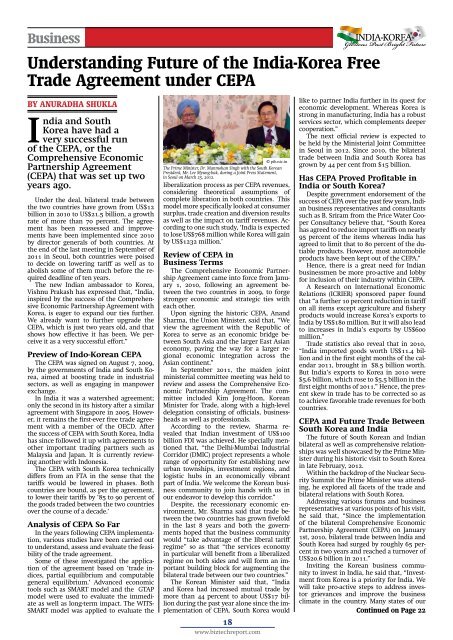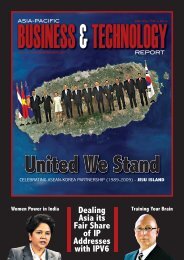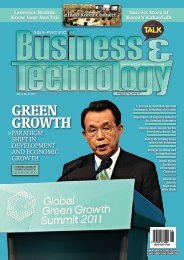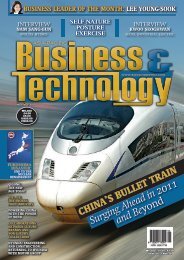INDIA-KOREA - Asia-Pacific Business and Technology Report
INDIA-KOREA - Asia-Pacific Business and Technology Report
INDIA-KOREA - Asia-Pacific Business and Technology Report
You also want an ePaper? Increase the reach of your titles
YUMPU automatically turns print PDFs into web optimized ePapers that Google loves.
<strong>Business</strong><br />
Underst<strong>and</strong>ing Future of the India-Korea Free<br />
Trade Agreement under CEPA<br />
by Anuradha Shukla<br />
India <strong>and</strong> South<br />
Korea have had a<br />
very successful run<br />
of the CEPA, or the<br />
Comprehensive Economic<br />
Partnership Agreement<br />
(CEPA) that was set up two<br />
years ago.<br />
Under the deal, bilateral trade between<br />
the two countries have grown from US$12<br />
billion in 2010 to US$21.5 billion, a growth<br />
rate of more than 70 percent. The agreement<br />
has been reassessed <strong>and</strong> improvements<br />
have been implemented since 2010<br />
by director generals of both countries. At<br />
the end of the last meeting in September of<br />
2011 in Seoul, both countries were poised<br />
to decide on lowering tariff as well as to<br />
abolish some of them much before the required<br />
deadline of ten years.<br />
The new Indian ambassador to Korea,<br />
Vishnu Prakash has expressed that, “India,<br />
inspired by the success of the Comprehensive<br />
Economic Partnership Agreement with<br />
Korea, is eager to exp<strong>and</strong> our ties further.<br />
We already want to further upgrade the<br />
CEPA, which is just two years old, <strong>and</strong> that<br />
shows how effective it has been. We perceive<br />
it as a very successful effort.”<br />
Preview of Indo-Korean CEPA<br />
The CEPA was signed on August 7, 2009,<br />
by the governments of India <strong>and</strong> South Korea,<br />
aimed at boosting trade in industrial<br />
sectors, as well as engaging in manpower<br />
exchange.<br />
In India it was a watershed agreement;<br />
only the second in its history after a similar<br />
agreement with Singapore in 2005. However,<br />
it remains the first-ever free trade agreement<br />
with a member of the OECD. After<br />
the success of CEPA with South Korea, India<br />
has since followed it up with agreements to<br />
other important trading partners such as<br />
Malaysia <strong>and</strong> Japan. It is currently reviewing<br />
another with Indonesia.<br />
The CEPA with South Korea technically<br />
differs from an FTA in the sense that the<br />
tariffs would be lowered in phases. Both<br />
countries are bound, as per the agreement,<br />
to lower their tariffs by ‘85 to 90 percent of<br />
the goods traded between the two countries<br />
over the course of a decade.’<br />
Analysis of CEPA So Far<br />
In the years following CEPA implementation,<br />
various studies have been carried out<br />
to underst<strong>and</strong>, assess <strong>and</strong> evaluate the feasibility<br />
of the trade agreement.<br />
Some of these investigated the application<br />
of the agreement based on ‘trade indices,<br />
partial equilibrium <strong>and</strong> computable<br />
general equilibrium.’ Advanced economic<br />
tools such as SMART model <strong>and</strong> the GTAP<br />
model were used to evaluate the immediate<br />
as well as long-term impact. The WITS-<br />
SMART model was applied to evaluate the<br />
© pib.nic.in<br />
The Prime Minister, Dr. Manmohan Singh with the South Korean<br />
President, Mr. Lee Myung-bak, during a Joint Press Statement,<br />
in Seoul on March 25, 2012.<br />
liberalization process as per CEPA revenues,<br />
considering theoretical assumptions of<br />
complete liberation in both countries. This<br />
model more specifically looked at consumer<br />
surplus, trade creation <strong>and</strong> diversion results<br />
as well as the impact on tariff revenues. According<br />
to one such study, ‘India is expected<br />
to lose US$768 million while Korea will gain<br />
by US$1232 million.’<br />
Review of CEPA in<br />
<strong>Business</strong> Terms<br />
The Comprehensive Economic Partnership<br />
Agreement came into force from January<br />
1, 2010, following an agreement between<br />
the two countries in 2009, to forge<br />
stronger economic <strong>and</strong> strategic ties with<br />
each other.<br />
Upon signing the historic CEPA, An<strong>and</strong><br />
Sharma, the Union Minister, said that, “We<br />
view the agreement with the Republic of<br />
Korea to serve as an economic bridge between<br />
South <strong>Asia</strong> <strong>and</strong> the larger East <strong>Asia</strong>n<br />
economy, paving the way for a larger regional<br />
economic integration across the<br />
<strong>Asia</strong>n continent.”<br />
In September 2011, the maiden joint<br />
ministerial committee meeting was held to<br />
review <strong>and</strong> assess the Comprehensive Economic<br />
Partnership Agreement. The committee<br />
included Kim Jong-Hoon, Korean<br />
Minister for Trade, along with a high-level<br />
delegation consisting of officials, businessheads<br />
as well as professionals.<br />
According to the review, Sharma revealed<br />
that Indian investment of US$100<br />
billion FDI was achieved. He specially mentioned<br />
that, “the Delhi-Mumbai Industrial<br />
Corridor (DMIC) project represents a whole<br />
range of opportunity for establishing new<br />
urban townships, investment regions, <strong>and</strong><br />
logistic hubs in an economically vibrant<br />
part of India. We welcome the Korean business<br />
community to join h<strong>and</strong>s with us in<br />
our endeavor to develop this corridor.”<br />
Despite, the recessionary economic environment,<br />
Mr. Sharma said that trade between<br />
the two countries has grown fivefold<br />
in the last 8 years <strong>and</strong> both the governments<br />
hoped that the business community<br />
would “take advantage of the liberal tariff<br />
regime” so as that “the services economy<br />
in particular will benefit from a liberalized<br />
regime on both sides <strong>and</strong> will form an important<br />
building block for augmenting the<br />
bilateral trade between our two countries.”<br />
The Korean Minister said that, “India<br />
<strong>and</strong> Korea had increased mutual trade by<br />
more than 44 percent to about US$17 billion<br />
during the past year alone since the implementation<br />
of CEPA. South Korea would<br />
18<br />
www.biztechreport.com<br />
<strong>INDIA</strong>-<strong>KOREA</strong><br />
Glorious Past Bright Future<br />
like to partner India further in its quest for<br />
economic development. Whereas Korea is<br />
strong in manufacturing, India has a robust<br />
services sector, which complements deeper<br />
cooperation.”<br />
The next official review is expected to<br />
be held by the Ministerial Joint Committee<br />
in Seoul in 2012. Since 2010, the bilateral<br />
trade between India <strong>and</strong> South Korea has<br />
grown by 44 per cent from $15 billion.<br />
Has CEPA Proved Profitable in<br />
India or South Korea?<br />
Despite government endorsement of the<br />
success of CEPA over the past few years, Indian<br />
business representatives <strong>and</strong> consultants<br />
such as B. Sriram from the Price Water Cooper<br />
Consultancy believe that, “South Korea<br />
has agreed to reduce import tariffs on nearly<br />
95 percent of the items whereas India has<br />
agreed to limit that to 80 percent of the dutiable<br />
products. However, most automobile<br />
products have been kept out of the CEPA.”<br />
Hence, there is a great need for Indian<br />
businessmen be more pro-active <strong>and</strong> lobby<br />
for inclusion of their industry within CEPA.<br />
A Research on International Economic<br />
Relations (ICRIER) sponsored paper found<br />
that “a further 10 percent reduction in tariff<br />
on all items except agriculture <strong>and</strong> fishery<br />
products would increase Korea’s exports to<br />
India by US$180 million. But it will also lead<br />
to increases in India’s exports by US$600<br />
million.”<br />
Trade statistics also reveal that in 2010,<br />
“India imported goods worth US$11.4 billion<br />
<strong>and</strong> in the first eight months of the calendar<br />
2011, brought in $8.5 billion worth.<br />
But India’s exports to Korea in 2010 were<br />
$5.6 billion, which rose to $5.5 billion in the<br />
first eight months of 2011.” Hence, the present<br />
skew in trade has to be corrected so as<br />
to achieve favorable trade revenues for both<br />
countries.<br />
CEPA <strong>and</strong> Future Trade Between<br />
South Korea <strong>and</strong> India<br />
The future of South Korean <strong>and</strong> Indian<br />
bilateral as well as comprehensive relationships<br />
was well showcased by the Prime Minister<br />
during his historic visit to South Korea<br />
in late February, 2012.<br />
Within the backdrop of the Nuclear Security<br />
Summit the Prime Minister was attending,<br />
he explored all facets of the trade <strong>and</strong><br />
bilateral relations with South Korea.<br />
Addressing various forums <strong>and</strong> business<br />
representatives at various points of his visit,<br />
he said that, “Since the implementation<br />
of the bilateral Comprehensive Economic<br />
Partnership Agreement (CEPA) on January<br />
1st, 2010, bilateral trade between India <strong>and</strong><br />
South Korea had surged by roughly 65 percent<br />
in two years <strong>and</strong> reached a turnover of<br />
US$20.6 billion in 2011.”<br />
Inviting the Korean business community<br />
to invest in India, he said that, “Investment<br />
from Korea is a priority for India. We<br />
will take pro-active steps to address investor<br />
grievances <strong>and</strong> improve the business<br />
climate in the country. Many states of our<br />
Continued on Page 22









